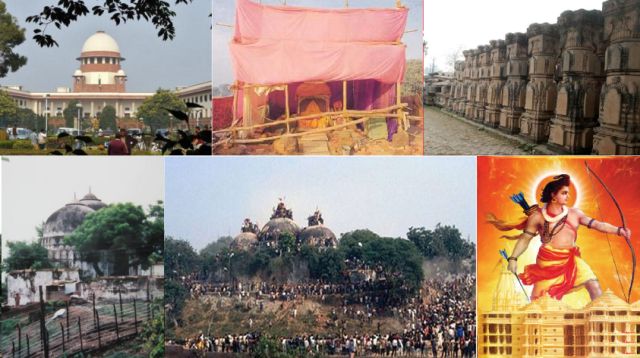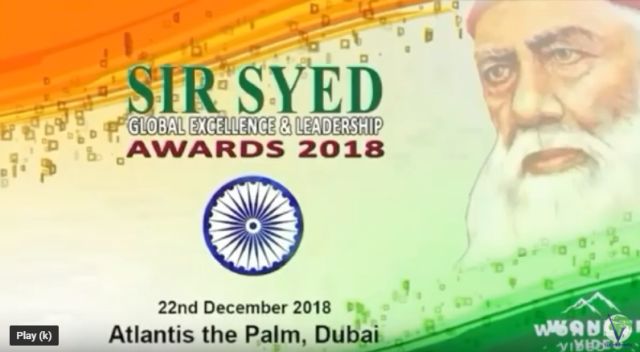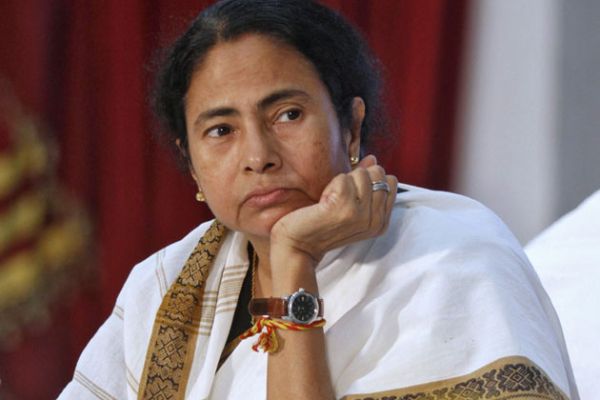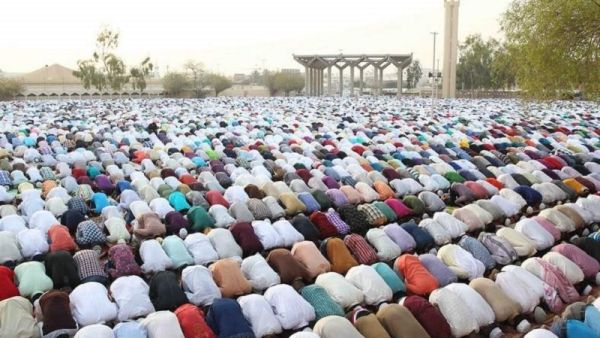
by admin | May 25, 2021 | News, Politics
 Lucknow : The Babri Masjid Action Committee (BMAC) has decided to file a petition in the Supreme Court in case the Narendra Modi-led NDA government at the Centre brings in an ordinance paving way for the construction of a grand Ram temple at the disputed site in Ayodhya, an office-bearer said on Wednesday.
Lucknow : The Babri Masjid Action Committee (BMAC) has decided to file a petition in the Supreme Court in case the Narendra Modi-led NDA government at the Centre brings in an ordinance paving way for the construction of a grand Ram temple at the disputed site in Ayodhya, an office-bearer said on Wednesday.
He said the BMAC took the decision at a meeting on Tuesday.
The move comes ahead of the January 4 hearing by the apex court on the matter.
While right-wing groups and the Rashtriya Swayamsewak Sangh (RSS) have been pressing for the ordinance, the opposition has been seeking a court verdict on the contentious issue.
One of the 70 persons, who attended the meeting, said it was a routine one and had no specific agenda. Though the possibility of the Modi government bringing in an ordinance or a legislation on the temple issue was discussed.
Convenor of the BMAC Zafaryab Jilani said the committee would also urge the Supreme Court to not rush through the matter and pronounce a verdict only after going through all aspects and studying all relevant papers and documents.
The BMAC members were also of the view that the Bharatiya Janata Party’s (BJP) electoral defeats in three states, the whipping up of passion on the temple issue and the pro-temple statements by senior BJP leaders, including Uttar Pradesh Chief Minister Yogi Adityanath, could not be taken in isolation or lightly.
—IANS

by admin | May 25, 2021 | Opinions
 Remarks
Remarks
Frank F. Islam On Purposeful Philanthropy for a Purpose-Driven Education For
Sir Syed Global Leadership Award 2108 in Dubai December 2018
Good Evening
Distinguished Guests, Friends, Ladies and Gentlemen:
Thank you very much for that kind introduction.
Thank you for your warm welcome and your hospitality.
I would like to express my deep gratitude to Pushkin Agha for inviting me to speak on this special occasion. Let us give him a big round of applause.
Thank you, Prof. Mansoor and Vice President Ansari and other distinguished guests, for joining us this evening. I want to thank the Vice Chancellor Mansoor for his vision of the kind of Aligarh we can build together. He provides the broad shoulder upon which we can stand.
Let me say a few words about Vice President Ansari. I want to thank him for being the guiding light and for helping and advocating to create a unified and just environment where people of different creeds and different faiths can all work together to help shape a better future for India and the world. I admire and respect his strong belief in embracing hope over fears and in building the most diverse, inclusive, and fair vision of India. His firm belief that we cannot be pulled apart and we need to stand together and we need to build bridges and to promote dialogue of understanding and a shared sense of community because we are Indian, bonds that binds us together. Mr. Vice President, we are here to help lighten your load.
It is truly an honor and humbling for me to be here will all of you Aligarh alums this evening. I feel a personal connection with all of you as we are linked by common cause, common goals, common vison and values, and common commitment. I also feel a common bond through shared history, shared heritage, shared background, and shared belief.
It is an honor because I come before you as a son of Aligarh and a brother to each of you. Like you I am part of the Aligarh family tree. I am here this evening because I have stood on the shoulders of giants. These giants have been the faculty, students, and the alumni of Aligarh Muslim University.
I am honored to receive the Sir Syed Global Philanthropist Excellence Award for 2018. Sir Syed Ahmed Khan is my hero. He was one of the greatest leaders in the history of AMU. We have been enriched and empowered by Sir Syed’s educational initiatives.
I accept this award with humility, not for me, but in recognition of all those Aligarh giants, who have made a difference in society through their leadership, education, and public service.
To be given any award named after Sir Syed is special. To be given an award that relates to philanthropy is even more so because it relates directly to the vision that Sir Syed had when he founded Aligarh Muslim University in 1875.
Sir Syed established AMU to provide its graduates with what I call a “purpose-driven education.” At the founding of Aligarh, Sir Syed said,
…from the seeds which we sow today there may spring up a mighty tree whose branches, like those of banyan of the soil shall in their turn strike firm roots into the earth, and themselves send forth new and vigorous saplings; that this College may expand into a University, whose sons shall go forth throughout the length and breadth of the land to preach the gospel of free inquiry, of large-hearted toleration, and of pure morality.
We are convened here in Dubai as the manifestation of and living testimony to the realization of Sir Syed’s vision.
We are seeds from the Aligarh family tree. We have gone around the world. In the process, we have planted new trees and helped make the world a better place.
We were able to do that because our Aligarh education gave us a strong knowledge base. It instilled in us a strong sense of values. It provided us a bridge to the future.
In a phrase, Aligarh gave all of us a “purpose driven education.” We are gathered here at a time when a “purpose-driven” education such as that we received has never been more important.
Over the years, men and women from Aligarh have made significant contributions in all walks of life – educators, politicians, poets, scientists, engineers. Their paths have been different but the common and transcendent bond that has united them has been a belief in and a commitment to equal justice and a shared humanity.
This combination of technical expertise and moral rectitude has enabled the graduates of Aligarh to make their mark in the world and to serve as positive role models for others. One of the ways that we can amplify that mark is through what I call “purposeful philanthropy.”
Let me elaborate on that concept. After that, I will make the connection between purposeful philanthropy and a purpose-driven education.
Philanthropy takes many forms. The philanthropy that is of pivotal importance, in my opinion, is purposeful philanthropy.
Purposeful philanthropy is making investments directed at creating a difference in pivot point areas that matter to the future of society. The returns on those investments are changes to problematic conditions and/or the creation of individuals who will become change agents to address those conditions.
There is a distinction between purposeful philanthropy and charity. The distinction is a critical one.
The focus in charity is to provide a handout. The focus in purposeful philanthropy is to provide a hand-up – to enable and empower people by giving them a helping hand.
There certainly must be charitable support and assistance to address the needs of the socially and economically disadvantaged and natural disasters.
Charity as the sole means of philanthropy, however, has serious limitations. It does not get at the root cause nor change the underlying reason for the need for the charity.
By contrast, purposeful philanthropy concentrates on improving circumstances and conditions. This hand-up approach can take a wide range of forms, ranging from eliminating contaminated water that poisons those who drink or bathe in it; to enhancing the safety of working conditions; to developing the requisite knowledge, skills, abilities, attitudes and behaviors for a person to be successful in life.
The pivot point areas — areas that can be leveraged and effectively addressed to effectuate change and achieve positive outcomes — for purposeful philanthropy are virtually endless. My personal priority philanthropic areas are education, arts, world peace and civic engagement.
I have chosen those areas because they are important to me and because I know that improvement in them can make a meaningful and substantial difference. Let me tell you a little bit about my investments in education at AMU.
Education is bridge to the future and an opportunity creator. It moves people up the ladder and to help others climb the ladder with them. It is a powerful equalizer for opening doors to lift people out of poverty. It is a gift that keeps on giving and demand that we give back in return.
In the educational arena, I have supported many scholarships at colleges in the United States and India. My wife Debbie and I have provided considerable financial support to build Frank and Debbie Islam Management Complex at AMU and have endowed an Entrepreneurship and Innovation Center. We also have provided financial support to build Frank and Debbie Islam Auditorium at AMU Mass Communications Department.
Let me say few words as to why we made investment to AMU. It is because AMU helped to make me who I am and for that I am deeply grateful. It provided me the basic building blocks to become a successful entrepreneur, to assume responsibilities, and to become a passionate leader. I have strong connection and bond to the past and the future of AMU. It shaped my story and determined my destiny. Its principles have always guided me during the time of calm or crisis. What is best in me, I owe it to AMU. I would not be the person I am if it was not Aligarh education. Aligarh students have always been our best hope. My investment is my way of saying Thank you and keeping the hope alive and well.
I have described my four pivot point areas – education, arts, world peace and civic engagement – for purposeful philanthropy for illustration purposes only.
Each of us must choose the area or areas that matter for our philanthropy. The essential thing is to make that choice and to invest.
The size of that investment isn’t what counts. The act of investment does.
Having said that, as I conclude my presentation, I would like to make one request of you. That is for you to consider making one of your purposeful philanthropic investments to support a purpose-driven education. Let me be more specific and ask you to consider making a philanthropic investment in AMU.
As I said earlier, I have provided support and continue to invest in AMU. In February of last year, I went to India to dedicate the Frank and Debbie Islam Management Complex at AMU. At the dedication of that Complex I said, “While the bricks and mortar are important, far more important is what will go on in this setting. It will be a place for sharing of information and imparting and development of knowledge. It will be a place where faculty and students can collaborate on innovative projects. It will be an educational empowerment zone.” I went on to predict, “From this Management Complex will come the future leaders who will make the world a better place.”
In this dedication remarks, I was sharing my perspective on purposeful philanthropy and my absolute and total belief in the role that AMU plays as a leader internationally in providing a purpose driven education.
As you all know, we are living in troubled and turbulent times. We are living in divisive and self-centered times.
Now, more than ever, it is imperative that students receive an education that prepares them to be “servant-leaders”: Leaders who understand that working with others to solve problems and that what one gives back is more important than what one accomplishes individually.
An Aligarh education meets that test and more. You know that. I know that. We know that. And, that is why we need to ensure that as many students as possible can become Aligarians.
In closing, let me leave you with one final thought from Sir Syed. Near the end of his life, he said:
“You have reached a particular stage and remember one thing that when I undertook this task, there were criticism all around against me, life has become so difficult for me that I aged before my age, I lost my hair, my eyesight, but not my vision. My vision never dimmed, and my determination never failed, I built this institution for you and I am sure, you will carry the light of this institution far and wide, darkness will disappear from all around.”
There is still much darkness all around and that is why we, as the seeds of the Aligarh family tree, must continue to deliver on Sir Syed’s vision by keeping Aligarh’s light burning “brightly”.
Thanks for listening to me and for your consideration of my thoughts and request.
It is great to be here with all of you. I look forward to getting to talk with many of you during the course of this wonderful event.
I wish you all the best
God bless you all

by admin | May 25, 2021 | Opinions, Politics

Mamata Banerjee
By Amulya Ganguli,
For a leader who enjoys a huge majority in the state assembly and faces virtually no credible challenge from her opponents, Mamata Banerjee is surprisingly insecure.
Her uncertainty about her political position could be seen in the violence unleashed by her party men during the panchayat elections last summer when 16,000 of the 50,000 seats went uncontested by the opposition parties apparently because the ruling Trinamool Congress activists scared away all her adversaries.
The Supreme Court had expressed shock over the absence – forced or otherwise – of the Trinamool Congress’s opponents in the polls. Now, the Calcutta High Court is considering her trepidations about the proposed Rath Yatras of the Bharatiya Janata Party (BJP). While an earlier judgment rejected the state government’s plea for banning the Yatras by saying that a threat of violence as argued by the government has to be “real, not imaginary or a likely possibility”, a subseauent verdict has favoured a closer look at what the intelligence agencies are saying.
There is little doubt, however, that Mamata Banerjee nowadays regards the BJP as a greater political threat than either the Congress, which has 42 seats in the assembly against the Trinamool Congress’s 213 in the 295-member House, or the Left which has 32. The BJP, in contrast, has three.
What is clearly worrying the Chief Minister is the jump in the BJP’s vote share from three per cent in 2013 to 23 per cent in a by-election this year where it secured the second place, relegating the Congress-Left combine to the third place. Moreover, a survey has predicted the BJP’s emergence as the principal opposition party in the state.
Behind the BJP’s rise is the perception that Mamata Banerjee is rather too lenient towards the Muslims as they comprise 28 per cent of the population. In addition, there is the longstanding problem of illegal immigrants from Bangladesh, who are called “termites” by BJP president Amit Shah.
The Chief Minister’s fear probably is that the proposed Rath Yatras will raise the issue of the “termites” and call for a headcount of the “ghuspetiyas” (infiltrators) under the National Register of Citizens (NRC) in West Bengal, similar to the enumeration that has already been carried out In Assam.
Reports suggest that Rashtriya Swayamsevak Sangh (RSS) foot soldiers are currently active in West Bengal with their propaganda in favour of an NRC on the grounds that if urgent steps are not taken, “then the Bengali Hindus will be aceannihilated”, as an RSS functionary has said.
The state government’s fears about the Rath Yatras are probably based on the fact that the processions taken out by the BJP on the occasion of Navratri with “weapons” in March had led to sporadic communal clashes, although they were not as serious as in neighbouring Bihar.
Although most people in West Bengal will consider Amit Shah’s boast of the BJP winning 22 of the 42 parliamentary seats in the state in 2019 as an instance of hyperbole, Mamata Banerjee cannot afford to take the “threat” lightly, for a rise in the BJP’s number of Lok Sabha seats from the present two with three runners-up will be a blow not only to her political prestige, but also to the state’s self-cultivated Leftist-“progressive” image.
An improved performance by the BJP will also undercut the Trinamool Congress leader’s national ambition as one of the architects of the anti-BJP mahagathbandhan (grand alliance) at the national level and of herself as a possible prime ministerial candidate.
As it is, the violence during the panchayat elections had shown her in poor light. Now, if the BJP Rath Yatras attract sizeable crowds, she will be even more on the defensive.
For a doughty fighter, who had routed the well-trenched Marxists, pushing them into a corner from where they are finding it difficult to emerge, the ascendancy is unthinkable of a north Indian party of vegetarian, cow-worshipping “Hindi-wallahs”, who revere a north Indian god like Ram, as a new member of the Trinamool Congress, who was earlier in the BJP, has said.
Arguably, Mamata Banerjee’s combative instincts are fired up when she has a battle on her hands. But the problem is that her party men are not among the most disciplined. Since many of them have switched to the Trinamool Congress from the Marxist communist party, they have a “history” of being violent.
But it is the BJP which will gain if the party is seen to be specifically targeted. As of now, the judiciary is with her, but she will be on a weak wicket if she tries too deseperately to stop what is undoubtedly the democratic right of an opposition party to take out Yatras. Her desperation can also be construed as a sign of being scared.
(Amulya Ganguli is a political analyst. The views expressed are personal. He can be reached at amulyaganguli@gmail.com)
—IANS

 Lucknow : The Babri Masjid Action Committee (BMAC) has decided to file a petition in the Supreme Court in case the Narendra Modi-led NDA government at the Centre brings in an ordinance paving way for the construction of a grand Ram temple at the disputed site in Ayodhya, an office-bearer said on Wednesday.
Lucknow : The Babri Masjid Action Committee (BMAC) has decided to file a petition in the Supreme Court in case the Narendra Modi-led NDA government at the Centre brings in an ordinance paving way for the construction of a grand Ram temple at the disputed site in Ayodhya, an office-bearer said on Wednesday.


